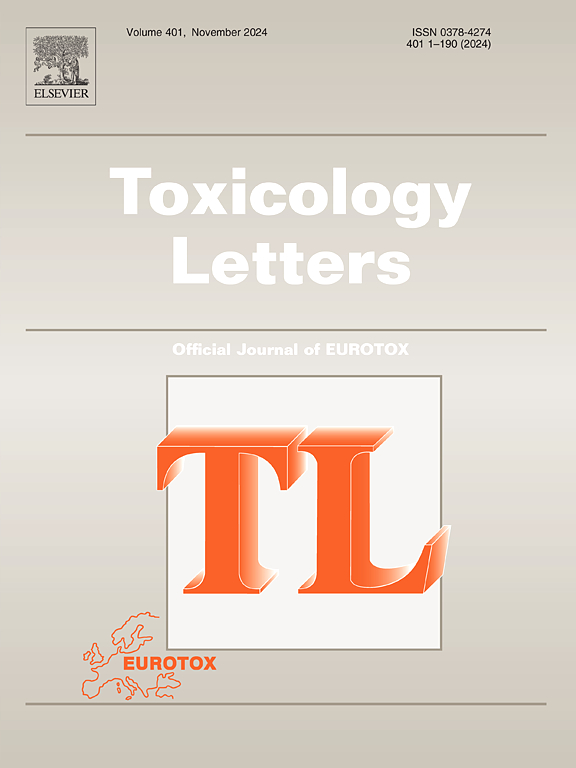低除草剂浓度对肝细胞转录组学的影响:2,4- d、草甘膦和AMPA的单独和联合效应
IF 2.9
3区 医学
Q2 TOXICOLOGY
引用次数: 0
摘要
草甘膦和2,4- d是全球使用最广泛的除草剂之一,导致环境存在,食品污染和人类接触。基于当前毒理学限制或基于人群的除草剂暴露的调查是必要的,体外生物测定为毒理学筛选提供了有用的工具。因此,本研究评估了非细胞毒性暴露于草甘膦、其代谢物氨基甲基膦酸(AMPA)或2,4- d或其混合物对肝细胞的转录组学影响。计算每种除草剂在人肝C3A细胞中的一半最大有效浓度(IC50)(细胞活力),并在暴露48 h后使用1000倍的低浓度进行转录组分析(RNA-Seq),类似于目前的毒理学限值,并考虑除草剂的水含量(草甘膦:0.95 µg/mL;AMPA: 3.7 µg / mL;2,4 - d: 0.56 µg / mL)。草甘膦暴露增加了mapk相关的生物过程(上调TNF、FOS、IGF1和PDGFB),并下调了与脂质代谢相关的基因(CD36和PPARA)。许多与AMPA暴露相关的差异表达基因(deg,如PFKFB3、HK2和ALDOA)与葡萄糖代谢途径有关。通过主成分分析和212个共享deg的功能,草甘膦及其代谢物产生了共同的分子特征。2,4- d暴露与JNK级联和溶质载体家族注释有关。尽管重要的上皮-间质过渡基因(COL11A2, LOXL3, SNAI1)被混合物修饰,但除草剂混合物对增强单个除草剂的影响具有离散效应。总之,我们的数据揭示了除草剂暴露在肝细胞中的短期分子效应的新视角,强调了进一步探索的潜在途径。本文章由计算机程序翻译,如有差异,请以英文原文为准。
Transcriptomic implications of low herbicide concentrations in hepatic cells: Insights into the individual and combined effects of 2,4-D, glyphosate, and AMPA
Glyphosate and 2,4-D are among the most widely used herbicides globally, leading to environmental presence, food contamination, and human contact. Investigations based on current toxicological limits or populational-based herbicide exposures are warranted, and in vitro bioassays provide useful tools for toxicological screening. Thus, this study evaluated the transcriptomic implications of non-cytotoxic exposures to glyphosate, its metabolite aminomethylphosphonic acid (AMPA), or 2,4-D - or to their mixes - on hepatic cells. The half maximal effective concentration (IC50) of each herbicide was calculated (cell viability) in human hepatic C3A cells and 1000-fold lower concentrations were used for transcriptomic analysis (RNA-Seq) after 48 h exposure, resembling current toxicological limits and considering herbicide water levels (glyphosate: 0.95 µg/mL; AMPA: 3.7 µg/mL; 2,4-D: 0.56 µg/mL). Glyphosate exposure enriched MAPK-related biological processes (upregulated TNF, FOS, IGF1, and PDGFB), and downregulated genes associated with lipid metabolism (CD36 and PPARA). Many AMPA exposure-related differentially expressed genes (DEGs, such as PFKFB3, HK2, and ALDOA) were associated with glucose metabolic pathways. Glyphosate and its metabolite yielded a common molecular signature, as illustrated by principal component analysis and the function of 212 shared DEGs. The exposure to 2,4-D was associated with the JNK cascade and the solute carrier family annotations. The herbicide mixtures had a discrete effect on enhancing the impact of individual herbicides, although important epithelial-mesenchymal transition genes were exclusively modified by the mixes (COL11A2, LOXL3, SNAI1). Altogether, our data reveals new perspectives on the short-term molecular effects of herbicide exposure in liver cells, emphasizing potential avenues for further exploration.
求助全文
通过发布文献求助,成功后即可免费获取论文全文。
去求助
来源期刊

Toxicology letters
医学-毒理学
CiteScore
7.10
自引率
2.90%
发文量
897
审稿时长
33 days
期刊介绍:
An international journal for the rapid publication of novel reports on a range of aspects of toxicology, especially mechanisms of toxicity.
 求助内容:
求助内容: 应助结果提醒方式:
应助结果提醒方式:


